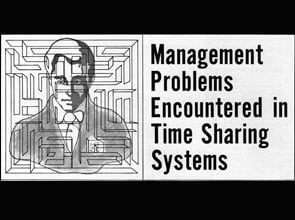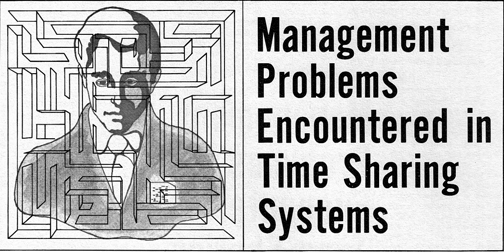
Management Problems Encountered in Time Sharing Systems
By
RICHARD L. CRANDALL
COMSHARE, INC.
November, 1969

Reprinted from COMPUTER SERVICES November/December 1969
Copyright 1969, A. Z. Publishing Corp„ 647 N. Sepulveda Blvd„ Belair, Calif, 90049
COMPUTER SERVICES is the official publication of ADAPSO, The Association for the Computer Services Industry
The development of currently available time-sharing services has combined both management and technological innovations, resulting in a new industry that is very much in general demand but that also has its own set of unique management problems. The success of an establishment involved in providing time-sharing services is thus largely dependent on its ability to make rapid, sound, technologically-based management decisions. Such decisions are necessary if a time-sharing company is to remain in the forefront of technological advances and the marketplace and is to support such technically oriented services.
Some of the major problems that consistently need to be dealt with are: selection of computer hardware; design of time-sharing systems, languages, and applications; provision of customer training and support; maintenance of a communications network; load distribution and marketplace orientation; and maintenance of sufficient system reliability.
SELECTION OF COMPUTER HARDWARE
One of the first and most important decisions that needs to be made by a time-sharing company is which computer to use, Twenty different computer models are currently in use by commercial time-sharing services. Each machine has its own advantages and disadvantages when used to run a time-sharing software system. Areas such as cycle time, raw throughput, and peripheral access times are secondary measuring points when compared to such major criteria as price performance evaluation in a dynamically changing environment.
When two computer systems are compared side by side with operational time-sharing software, disagreement will always be voiced as to how effective the evaluation was, due to variances in user loads, The problem of which piece of hardware to procure completely eludes definitive resolution when attempts are made to compare two proposed time-sharing software designs on two existing different kinds of hardware. In final analysis, the proper decision can only be made by a highly competent time-sharing software design staff, since it is they who must implement a time-sharing system on the hardware and provide responsive and reliable performance.
DESIGN OF TIME-SHARING SOFTWARE
Competent, efficient, and reliable software for time-sharing has yet to be provided by the computer hardware manufacturer. The most successful half dozen time-sharing companies either wrote their own software systems or obtained them from universities or small, independent programming groups. Software, therefore, becomes one of the major “values-added” for a time-sharing company, and it behooves the company to procure the best software design staff it can muster.
New methods of file security will be found to protect the user not only from unwanted intruders, but from himself.
This is a difficult task because retaining and motivating highly capable software design people is a problem in itself. The short supply of these people in the nation and in the world is significant; in several important areas software design can make or break a time-sharing company.
One of the major advances that time-sharing has brought to the marketplace is the direct on-line, man-machine communication process. When the user is running his problem he is on-line, directly communicating with the computer. Direct man-machine interface requires that system software design people have a thorough understanding and knowledge of human factors considerations so that remote users can effectively utilize the system. The human factors problem is how to optimize the interaction – how to best carry out the dialogue between a man and a machine.
Items such as the selection of either a half duplex or a full duplex transmission network, provision of multilevel diagnostics for either the inexperienced or experienced user, the text editing control to correct typing errors and maintain data files are but a few of the overriding software design considerations, The user must be promptly reassured if he makes an error, and he must be able to correct his errors rapidly and get on with his work.
Software design also involves an ongoing effort not only to resolve but to anticipate problems in standardization, variations in user sophistication, and reactions to errors.
Human factor problems inherent in the slow rate of transmission of data must also be solved, Both the man and the machine are capable of extremely fast communication, but the limitations of present terminals continue to frustrate the time-sharing user.
Language selection requires management as well as design decisions because of its effect on product planning. Approximately 58% of time-sharing users use Fortran or some variation of it; 32% use BASIC or one of its variations; and the remaining 10% are using one of some 30 other computer languages for their own specialized needs. A time-sharing company must decide which of these languages to incorporate into its basic service. Otherwise, time-sharing users may find themselves using more than one time-sharing service to obtain the language selection they need.
File security and user protection are other areas requiring constant design attention. The ability of a time-sharing system to provide service to many users simultaneously necessitates the inclusion of appropriate measures in the system to protect users from other users. A combination of bath hardware and software features as well as constant monitoring is required. As time-sharing systems become more applications oriented, file structures will become more lenient, allowing shared files to be accessed by selective groups of people simultaneously. New methods of file security will be implemented to protect the user not only from unwanted intruders but also from himself. Again, the system designer must keep human factor tradeoffs in mind so that the system does not become overburdened with passwords and codes.
APPLICATIONS, CUSTOMER TRAINING, AND SUPPORT
The need for greater market penetration is recognized by the entire time-sharing industry, and increasing expenditures of money and resources for the development of industry-oriented applications characterize the new wave of marketing philosophy. Time-sharing is a tool which needs to be geared toward solving end-user problems; it should not require programming experience.
Application packages are very user-sensitive and can only be developed through cooperation between the user and industry specialists who address themselves to practical problems. Applications development can only be achieved by significant contributory efforts on the part of time-sharing companies.
The newer on-line systems have been acclaimed to be easier to use than previous batch processing systems. However, significant customer training and support is still required. The fact that the user is directly using the computing system and controlling its activities must never be forgotten. Properly designed software requires less training of the user in how to use a particular application package or language, but training is still required in the use of the terminal and some of the basic features of the time-sharing system.
Typically, time-sharing companies have one sales support person for every salesman in the field. Support personnel introduce customers to the system and do a certain amount of training, but, more importantly, they keep the user up to date on new features and suggest better means of solving problems. Consequently, a time-sharing company must recognize the need for an organizational structure which will keep sales support personnel updated, Support people need to have an extensive general knowledge of the entire time-sharing system’s operations and features, and they require continual internal training. The availability of personnel with such a level of competence is almost as limited as good software design personnel.
MAINTENANCE OF THE COMMUNICATIONS NETWORK
The user of a time-sharing service is dependent upon remote communications to a centrally located computer. Therefore, a time-sharing company must become expert in the operation and maintenance of a national or even international communication network, A good deal of material is generally available today on common carrier problems, communication economics,
The company must be able to provide government agencies with actual commercial experiences so appropriate regulatory decisions can be made.
and terminal selection and maintenance. A time-sharing company must deal with all of these problems because it cannot rely on communications vendors for trouble-free service.
Since governmental agencies are now making decisions which affect the communications requirements of a time-sharing company, the company must also keep itself informed on government rulings. In addition, the company must be in a position to provide government agencies with actual commercial experience and valid input so that appropriate regulatory decisions can be made.
Time-sharing companies must assume a systems responsibility for the service which they provide, including not only computer hardware and software reliability but also communications and remote terminal reliability. The user must not be put in a position where he has to worry about maintenance and repair of any of the devices that comprise time-sharing service.
LOAD DISTRIBUTION AND MARKETPLACE ORIENTATION
The primary operational control problem facing a time-sharing company is that of balancing the load its customers place on the system, with respect to time of day and the nature of specific applications. No time-sharing system yet can do all things for all people, and most have an orientation towards particular kinds of customers. The orientation may be a design parameter via the hardware and software, or it may be a function of the marketing approach, Design decisions must dictate whether a system is to be highly interactive, conversational, and oriented towards the on-line, short-response type of user, or whether it is to be a generally more efficient system, less responsive but with higher CPU throughput capabilities.
Software design decisions that affect the type of customer base operational on the machine must be made and re-made. A time-sharing company optimizes its customer base by realizing the strong points of the system and selling those strong points.
Regardless of customer base, it is also the duty of the time-sharing company to attempt to balance its load throughout time during that portion of each day when the system is in operation. Utilization of non-prime time hours has become a major problem for time-sharing companies. Some potential solutions include the development of application programs for the recreation industry (which generally is in full force in the evening), non-prime time price discounts, and free non-prime time for new users,
As systems grow in capability and capacity, remote batch processing and deferred batch processing will be performed on time-sharing machines; deferred jobs will be then run during non-prime time. The need for this capability is yet another motivation for maintaining an advanced software group capable of rapid technological advancement.
MAINTENANCE OF RELIABILITY
Reliability considerations are of much greater importance to the operator of a time-sharing system than to the operator of batch processing systems. The reason for this lies in the on-line nature of a time-sharing system. Many customers utilizing the system at one time will simultaneously realize the effects of a system crash which interrupts their work. Major human factors problems are associated with a system crash because many people who are using the system are inexperienced in the system’s operation and become very confused when it fails them.
To assure proper maintenance, the time-sharing company itself must maintain constant vigil over the manufacturer’s maintenance procedures. I n the future, a typical time-sharing company will perform its own maintenance in order to guarantee higher reliability standards. This is another example of the need for a time-sharing company to take the approach of total systems responsibility. The company must contend with remote terminal maintenance, communication network maintenance, and software and hardware maintenance if it is to provide its users with total reliability.
TOTAL COMMITMENT
Each of the discussed problem areas is significant enough to represent difficulty to a time-sharing company, To cope with them in total is a difficult job indeed. The solutions to the and other problems require expert people, significant economic resource, and most important, a truly dedicated management and staff that concentrates solely on the business of time-sharing,
This new field, at the edge of technology, is already a commercial product. Its development is an effort well worth the while, for today the user organization can choose among many time-sharing companies and obtain a reliable, low cost service to meet its computing needs without having to procure, operate, and maintain a machine and develop software of its own.
Industrial corporations, educational institutions, government agencies – virtually all institutions which require problem solving capability – have a new tool at their fingertips. The trend is very definitely towards computer users relying on external organizations for computer power, on organizations that have developed the expertise and personnel required to provide good service.
An independent vendor can provide better service for less cost than an in-house installation-and users are realizing this.
Many corporations are realizing that even though it might seem on the surface that an in-house installation is cheaper than buying an outside service, an independent vendor can actually provide better service for less cost than an in-house installation, once all of the intangible costs are added up. Vendor interface, supplies inventory and procurement, training, updating, communications, documentation, and technical decision making are all hidden costs that must be considered when computer usage decisions are made.
Still another consideration is that technological enhancements do not occur in-house; non-technical upper management is generally unwilling to commit significant dollar and manpower resources for what is basically an overhead item. Time sharing companies, on the other hand, achieve economy of scale for operations and commit themselves to technological enhancement as a matter of survival.

Richard L. Crandall, Executive Vice President of Com-Share Inc., is responsible for the R&D, Marketing and Operations Divisions. Before joining Com-Share as one of the original incorporators, Mr. Crandall taught digital programming at the University of Michigan and worked for the University’s Computing Center, He has authored several papers and presented many lectures on time-sharing system and language design, applications, communications and time — sharing philosophy. He has served as Chairman of the SDS Time-Sharing Group and is a member of the IEEE, the Association for Computing Machinery, and the Operations Research Society of America. He presently chairs the FCC Inquiry Committee for ADAPSO.


